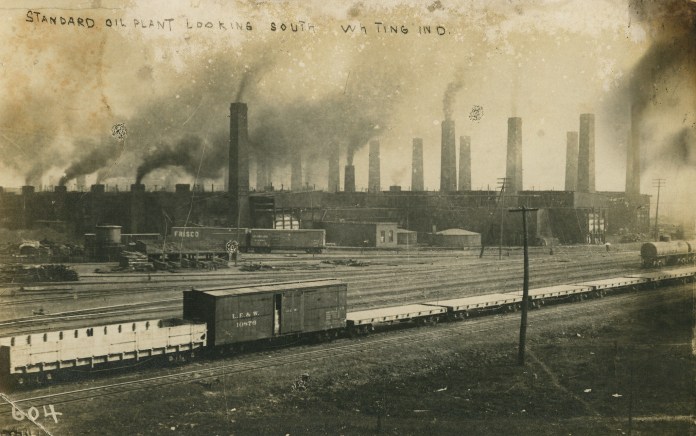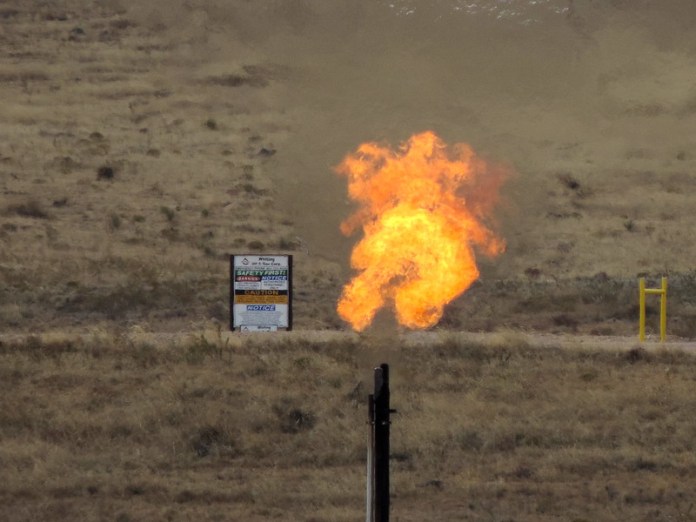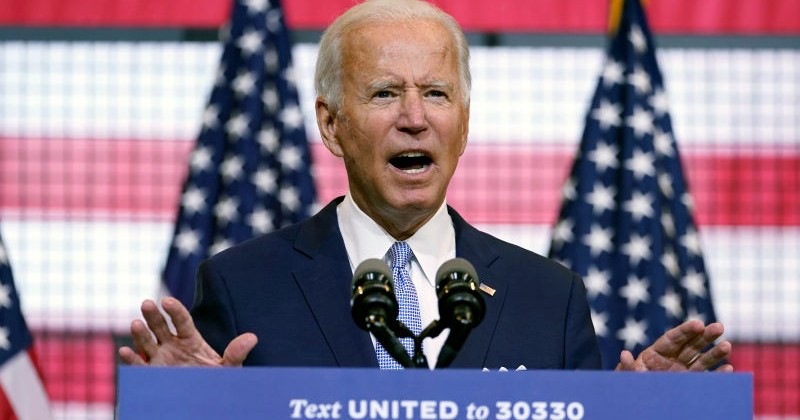This article is published as part of Covering Climate Now, a global collaboration of news outlets strengthening coverage of the climate story.
Despite countless investigations, lawsuits, social shaming, and regulations dating back decades, the oil and gas industry remains formidable. After all, it has made consuming its products seem like a human necessity. It has confused the public about climate science, bought the eternal gratitude of one of America’s two main political parties, and repeatedly out-maneuvered regulatory efforts. And it has done all this, in part, by thinking ahead and then acting ruthlessly. While the rest of us were playing checkers, its executives were playing three-dimensional chess.
Take this brief tour of the industry’s history, and then ask yourself: Is there any doubt that these companies are now plotting to keep the profits rolling in, even as mega-hurricanes and roaring wildfires scream the dangers of the climate emergency?
The John D. Rockefeller myth
Ida Tarbell is one of the most celebrated investigative journalists in American history. Long before Bob Woodward and Carl Bernstein exposed the Watergate scandal, Tarbell’s reporting broke up the Standard Oil monopoly. In 19 articles that became a widely read book, History of the Standard Oil Company, published in 1904, she exposed its unsavory practices. In 1911, federal regulators used Tarbell’s findings to break Standard Oil into 33 much smaller companies.

David had slain Goliath. The U.S. government had set a monopoly-busting standard for future generations. John D. Rockefeller, Standard Oil’s owner, lost. The good guys won — or so it seemed.
In fact Rockefeller saw what was coming and ended up profiting — massively — from the breakup of his company. Rockefeller made sure to retain significant stock holdings in each of Standard Oil’s 33 offspring and position them in different parts of the U.S. where they wouldn’t compete against one another. Collectively, the 33 offspring went on to make Rockefeller very, very rich. Indeed, it was the breakup of Standard Oil that tripled his wealth and made him the wealthiest man in the world. In 1916, five years after Standard Oil was broken up, Rockefeller became the world’s first billionaire.
Say it ain’t so, Dr. Seuss!
One of the offspring of Standard Oil was Esso (S-O, spelled out), which later launched one of the most successful advertising campaigns in history. It did so by relying on the talents of a young cartoonist who millions would later adore under his pen name, Dr. Seuss. Decades before authoring the pro-environment parable The Lorax, Theodore Geisel helped Esso market “Flit,” a household spray gun that killed mosquitoes. What Americans weren’t told was that the pesticide DDT made up 5% of each blast of Flit.
When Esso put considerable creative resources behind the Flit campaign, they were looking years ahead to a time when they would also successfully market oil-based products. The campaign ran for 17 years in the 1940s and 1950s, at the time an unheard length of time for an ad campaign. It taught Esso and other Standard Oil companies how to sell derivative products (like plastic and pesticides) that made the company and the brand a household name in the minds of the public. In its day, “Quick, Henry, the Flit!” was as ubiquitous as “Got Milk?” is today.
At the time, the public (and even many scientists) didn’t appreciate the deadly nature of DDT. That didn’t come until the 1962 publication of Rachel Carson’s book Silent Spring. But accepting that DDT was deadly was hard, in part because of the genius of Geisel, whose wacky characters — strikingly similar to the figures who would later populate Dr. Seuss books — energetically extolled Flit’s alleged benefits.
Geisel later said the experience “taught me conciseness and how to marry pictures with words.” The Flit ad campaign was incredibly smart and clever marketing. It taught the industry how to sell a dangerous and unnecessary product as if it were something useful and even fun.
Years later, ExxonMobil would take that cleverness to new heights in its advertorials. They weren’t about clever characters. But they were awfully clever, containing few, if any, outright lies, but a whole lot of half-truths and misrepresentations. It was clever enough to convince the New York Times to run them without labeling them as the advertisements that they, in fact, were. Their climate “advertorials” appeared in the op-ed page of the New York Times and were part of what scholars have called “the longest, regular (weekly) use of media to influence public and elite opinion in contemporary America.”
Controlling climate science
Big Oil also saw climate change coming. As abundant investigative reporting and academic studies have documented, the companies’ own scientists were telling their executives in the 1970s that burning more oil and other fossil fuels would overheat the planet. (Other scientists had been saying so since the 1960s.) The companies responded by lying about the danger of their products, blunting public awareness, and lobbying against government action. The result is today’s climate emergency.
Less well known is how oil and gas companies didn’t just lie about their own research. They also mounted a stealth campaign to monitor and influence what the rest of the scientific community learned and said about climate change.
The companies embedded scientists in universities and made sure they were present at important conferences. They nominated them to be contributors to the Intergovernmental Panel on Climate Change, the U.N. body whose assessments from 1990 onward defined what the press, public and policymakers thought was true about climate science. While the IPCC reports, which rely on consensus science, were sound, Big Oil’s scientific participation gave them an insider’s view of the road ahead. More ominously, they introduced the art of questioning the consensus science in forums where every word is parsed.
The industry was employing a strategy pioneered by tobacco companies, but with a twist. Beginning in the 1950s, the tobacco industry cultivated a sotto voce network of scientists at scores of American universities and medical schools, whose work it funded. Some of these scientists were actively engaged in research to discredit the idea that cigarette smoking was a health risk, but most of it was more subtle; the industry supported research on causes of cancer and heart disease other than tobacco, such as radon, asbestos and diet. It was a form of misdirection, designed to deflect our attention away from the harms of tobacco and onto other things. The scheme worked for a while, but when it was exposed in the 1990s, in part through lawsuits, the bad publicity largely killed it. What self-respecting scientist would take tobacco industry money after that?
The oil and gas industry learned from that mistake and decided that, instead of working surreptitiously, it would work in the open. And rather than work primarily with individual scientists whose work might be of use, it would seek to influence the direction of the scientific community as a whole. The industry’s internal scientists continued to do research and publish peer-reviewed articles, but the industry also openly funded university collaborations and other researchers. From the late 1970s through the 1980s, Exxon was known both as a climate research pioneer, and as a generous patron of university science, supporting student research and fellowships at many major universities. Its scientists also worked alongside senior colleagues at NASA, the Department of Energy and other key institutions, and funded breakfasts, luncheons and other activities at scientific meetings. Those efforts had the net effect of creating goodwill and bonds of loyalty. It’s been effective.
The industry’s scientists may have been operating in good faith, but their work helped delay public recognition of the scientific consensus that climate change was unequivocally man-made, happening now, and very dangerous. The industry’s extensive presence in the field also gave it early access to cutting edge research it used to its advantage. Exxon, for example, designed oil platforms to accommodate more rapid sea-level rise, even as the company publicly denied that climate change was occurring.
Don’t call it methane, it’s ‘natural gas’
Methane is an even more powerful greenhouse gas than carbon dioxide, yet it has received far less attention. One reason is that the oil and gas industry has positioned methane — which marketing experts cleverly labeled “natural gas” — as the future of the energy economy. The industry promotes methane gas as a “clean” fuel that’s needed to bridge the transition from today’s carbon economy to tomorrow’s renewable energy era. Some go further and see gas as a permanent part of the energy landscape: BP’s plan is renewables plus gas for the foreseeable future, and the company and other oil majors frequently invoke “low carbon” instead of “no carbon.”
Except that methane gas isn’t clean. It’s about 80 times more potent at trapping heat in the atmosphere than carbon dioxide is.

As recently as a decade ago, many scientists and environmentalists viewed “natural gas” as a climate hero. The oil and gas industry’s ad guys encouraged this view by portraying gas as a coal killer. The American Petroleum Institute paid millions to run its first-ever Super Bowl ad in 2017, portraying gas as an engine of innovation that powers the American way of life. Between 2008 and 2019, API spent more than $750 million on public relations, advertising, and communications (for both oil and gas interests), an analysis by the Climate Investigations Center found. Today, most Americans view gas as clean, even though science shows that we can’t meet our climate goals without quickly transitioning away from it. The bottom line is that we can’t solve a problem caused by fossil fuels with more fossil fuels. But the industry has made a lot of us think otherwise.
There’s little chance the oil and gas industry can defeat renewable energy in the long term. Wind, solar and geothermal, which are clean and cost-competitive, will eventually dominate energy markets. Researchers at the University of California, Berkeley, GridLab and Energy Innovation have found that the U.S. can achieve 90% clean electricity by the year 2035 with no new gas and at no additional cost to consumers.
But the oil and gas industry doesn’t need to win the fight in the long term. It just needs to win right now so it can keep developing oil and gas fields that will be in use for decades to come. To do that, it just has to keep doing what it has done for the past 25 years: Win today, fight again tomorrow.
A spider’s web of pipelines
Here’s a final example of how the oil and gas industry plans for the next war even as its adversaries are still fighting the last one. Almost no one outside of a few law firms, trade groups, and congressional staff in Washington, DC, knows what the Federal Energy Regulatory Commission is or does. But the oil and gas industry knows and it moved quickly after Donald Trump became president to lay the groundwork for decades of future fossil fuel dependency.
FERC has long been a rubber stamp for the oil and gas industry. The industry proposes gas pipelines, and FERC approves them. When FERC approves a pipeline, that approval grants the pipeline eminent domain, which in effect makes the pipeline all but impossible to stop.
Eminent domain gives a company the legal right to build a pipeline through landowners’ properties, and there is nothing they or state or county officials can do about it. A couple of states have successfully, though temporarily, blocked pipelines by invoking federal statutes such as the Clean Water Act. But if those state cases reach the current Supreme Court, the three justices Trump appointed — Neil Gorsuch, Brett Kavanaugh and Amy Coney-Barrett — are almost certain to rule in the industry’s favor.
Oil and gas industry executives seized upon Trump’s arrival in the White House. In the opening days of his administration, independent researchers listened in on public trade gatherings of the executives, who talked about “flooding the zone” at FERC. The industry planned to submit not just one or two but nearly a dozen interstate gas pipeline requests. Plotted on a map, the projected pipelines covered so much of the U.S. that they resembled a spider’s web.

Once pipelines are in the system, companies can start to build them, and utility commissioners in every corner of America see this gas “infrastructure” as a fait accompli. And pipelines are built to last decades. In fact, if properly maintained, a pipeline can last forever in principle. This strategy could allow the oil and gas industry to lock in fossil fuel dependency for the rest of the century.
In hindsight, it’s clear that oil and gas industry leaders used outright climate denial when it suited their corporate and political interests throughout the 1990s. But now that outright denial is no longer credible, they’ve pivoted from denial to delay. Industry PR and marketing efforts have shifted massive resources to a central message that, yes, climate change is real, but that the necessary changes will require more research and decades to implement, and above all, more fossil fuels. Climate delay is the new climate denial.
Nearly every major oil and gas company now claims that they accept the science and that they support sensible climate policies. But their actions speak louder than words. It’s clear that the future they want is one that still uses fossil fuels abundantly — regardless of what the science says. Whether it is selling deadly pesticides or deadly fossil fuels, they will do what it takes to keep their products on the market. Now that we’re in a race to a clean energy future, it’s time to recognize that they simply can’t be trusted as partners in that race. We’ve been fooled too many times.
Related posts:
Views: 0
 RSS Feed
RSS Feed

















 December 12th, 2021
December 12th, 2021  Awake Goy
Awake Goy 







 Posted in
Posted in  Tags:
Tags: 
















